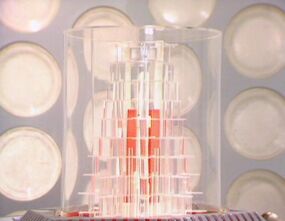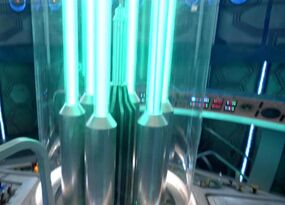Time rotor: Difference between revisions
No edit summary |
|||
| Line 16: | Line 16: | ||
Some time during the Doctor's [[Seventh Doctor|seventh life]], he reconfigured the TARDIS. In this design, the time rotor was a tall, transparent tube which attached to the ceiling as well as the console. Inside were a pair of glowing, opaque, blue-white tube assemblies which would rise and fall in alternation during flight, meshing and unmeshing in the centre. ([[TV]]: ''[[Doctor Who (1996)|Doctor Who]]'') | Some time during the Doctor's [[Seventh Doctor|seventh life]], he reconfigured the TARDIS. In this design, the time rotor was a tall, transparent tube which attached to the ceiling as well as the console. Inside were a pair of glowing, opaque, blue-white tube assemblies which would rise and fall in alternation during flight, meshing and unmeshing in the centre. ([[TV]]: ''[[Doctor Who (1996)|Doctor Who]]'') | ||
[[File:CentralColumn2013.jpg|thumb|The [[Eleventh Doctor]]'s time rotor. ([[TV]]: ''[[The Snowmen]]'')]] | [[File:CentralColumn2013.jpg|thumb|The [[Eleventh Doctor]]'s time rotor. ([[TV]]: ''[[The Snowmen]]'')]] | ||
The [[Ninth Doctor|Ninth]] and [[Tenth Doctor]]s' time rotor also reached the ceiling, and contained a glowing, | The [[Ninth Doctor|Ninth]] and [[Tenth Doctor]]s' time rotor also reached the ceiling, and contained a glowing, turquoise, transparent inner assembly of tubes. ([[TV]]: ''[[Rose (TV story)|Rose]]'') When that console room was destroyed and a new one regenerated by the TARDIS, the [[Eleventh Doctor]] was greeted by a time rotor which contained transparent, bulbous inner components resembling blown glass. ([[TV]]: ''[[The Eleventh Hour]]'') However, as the Doctor became seclusive after the departure of the Ponds, The TARDIS interior regenerated once again, reflecting the Doctor's darker disposition. Because of this change, a new console was introduced, and with it a new Time Rotor, composed of a hexagonal array of neon turquoise tubes that connected the ceiling to the console (as it's previous incarnations). Though while in contrast the newer rotor appears to be fixed, lights inside the tubes rhythmically flash in sequence when in flight, stimulate the 'pumping' motion of the temporal piston. There are also two small crystal-like prisms in the top and bottom centers of the the time rotor that physically pump up and down. ([[The Snowmen (TV story)]]/[[The Bells of Saint John (TV story)]]) | ||
This new incarnation of the Time Rotor is very reminiscent of the [[8th Dcotor]]'s and [[Ninth Doctor|Ninth]] / [[Tenth Doctor]]'s TARDIS time rotors. | |||
The console in the TARDIS' [[TARDIS console room#Secondary control room|secondary console room]] lacked a visible time rotor; in its place on the secondary console was a shaving mirror. ([[TV]]: ''[[The Masque of Mandragora]]'') | The console in the TARDIS' [[TARDIS console room#Secondary control room|secondary console room]] lacked a visible time rotor; in its place on the secondary console was a shaving mirror. ([[TV]]: ''[[The Masque of Mandragora]]'') | ||
Revision as of 06:10, 3 April 2013
There's an image of The Snowmen onwards' rotor, but no description of it?
These omissions are so great that the article's factual accuracy has been compromised. Check out the discussion page and revision history for further clues about what needs to be updated in this article.
The time rotor was a component in the central column of the TARDIS console. While the TARDIS was in flight, the rotor rose and fell, stopping when the TARDIS reached a destination. It was associated with the 'whooshing' noise heard when the TARDIS was in flight.
The time rotor was connected to the lower engines; hence as the TARDIS moved the rotor moved accordingly. As well as signifying the TARDIS' movement, the rotor was also known to stop working when something went wrong, e.g. the rotor stopped moving as the TARDIS engines stalled. This might be rectified by thumping the console. (TV: Doctor Who)
If the glass protecting the time rotor was damaged, such as when Mels shot it, a poisonous gas would come out of it until the extractor fans were activated. (TV: Let's Kill Hitler)
The Doctor's TARDIS
As with the rest of the Doctor's TARDIS, the aesthetic design of the time rotor occasionally changed throughout the Doctor's travels. As it varied through designs, it alternated between being a single column and a series of components that moved into each other from above and below. From the start it usually took the shape of a short, transparent cylinder containing an assortment of components, which rose, fell, and illuminated during flight, red/orange in colour. (TV: An Unearthly Child, et al.) The Fourth Doctor occasionally placed his hat atop the time rotor. (TV: The Stones of Blood)
At one point during the Doctor's sixth incarnation, Frobisher assumed the form of the time rotor. (COMIC: The Shape Shifter)
Some time during the Doctor's seventh life, he reconfigured the TARDIS. In this design, the time rotor was a tall, transparent tube which attached to the ceiling as well as the console. Inside were a pair of glowing, opaque, blue-white tube assemblies which would rise and fall in alternation during flight, meshing and unmeshing in the centre. (TV: Doctor Who)
The Ninth and Tenth Doctors' time rotor also reached the ceiling, and contained a glowing, turquoise, transparent inner assembly of tubes. (TV: Rose) When that console room was destroyed and a new one regenerated by the TARDIS, the Eleventh Doctor was greeted by a time rotor which contained transparent, bulbous inner components resembling blown glass. (TV: The Eleventh Hour) However, as the Doctor became seclusive after the departure of the Ponds, The TARDIS interior regenerated once again, reflecting the Doctor's darker disposition. Because of this change, a new console was introduced, and with it a new Time Rotor, composed of a hexagonal array of neon turquoise tubes that connected the ceiling to the console (as it's previous incarnations). Though while in contrast the newer rotor appears to be fixed, lights inside the tubes rhythmically flash in sequence when in flight, stimulate the 'pumping' motion of the temporal piston. There are also two small crystal-like prisms in the top and bottom centers of the the time rotor that physically pump up and down. (The Snowmen (TV story)/The Bells of Saint John (TV story)) This new incarnation of the Time Rotor is very reminiscent of the 8th Dcotor's and Ninth / Tenth Doctor's TARDIS time rotors.
The console in the TARDIS' secondary console room lacked a visible time rotor; in its place on the secondary console was a shaving mirror. (TV: The Masque of Mandragora)
Other TARDISes
The design of time rotor and console of the Master's TARDIS tended to be similar to the Doctor's. (TV: The Ultimate Foe) The same was also true for the Monk's TARDIS. (TV: The Meddling Monk)
The time rotor in the Rani's TARDIS was a pair of bare, rotating, metallic rings rather than a cylinder. (TV: The Mark of the Rani)
The Junk TARDIS built by the Eleventh Doctor and Idris featured a short time rotor salvaged from a dead TARDIS, plugged into a similarly salvaged console. It contained lights and metal components. It glowed pink when activated with a touch by Idris. (TV: The Doctor's Wife)
Behind the scenes
- In the non-canon Dalek movie spin-offs, Dr. Who and the Daleks and Daleks' Invasion Earth 2150 A.D., the TARDIS lacked the time rotor or even a central console.
- The time rotor was first mentioned by Vicki in The Chase, although in that story she pointed at a panel on the console instead of the central column.



